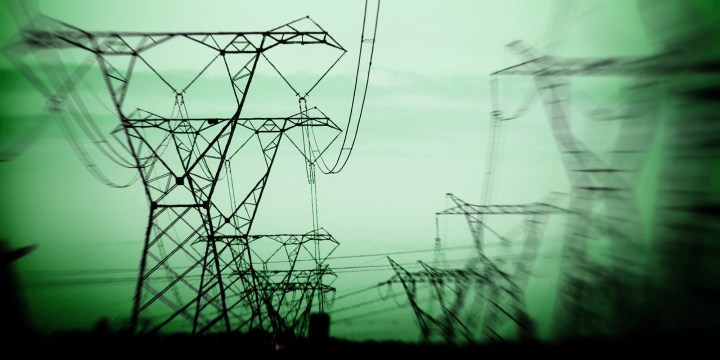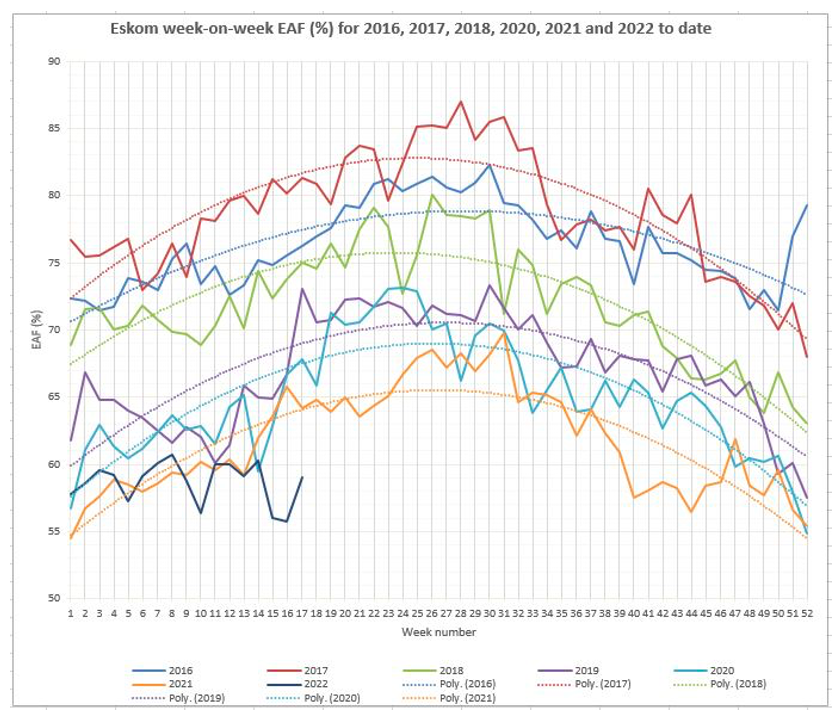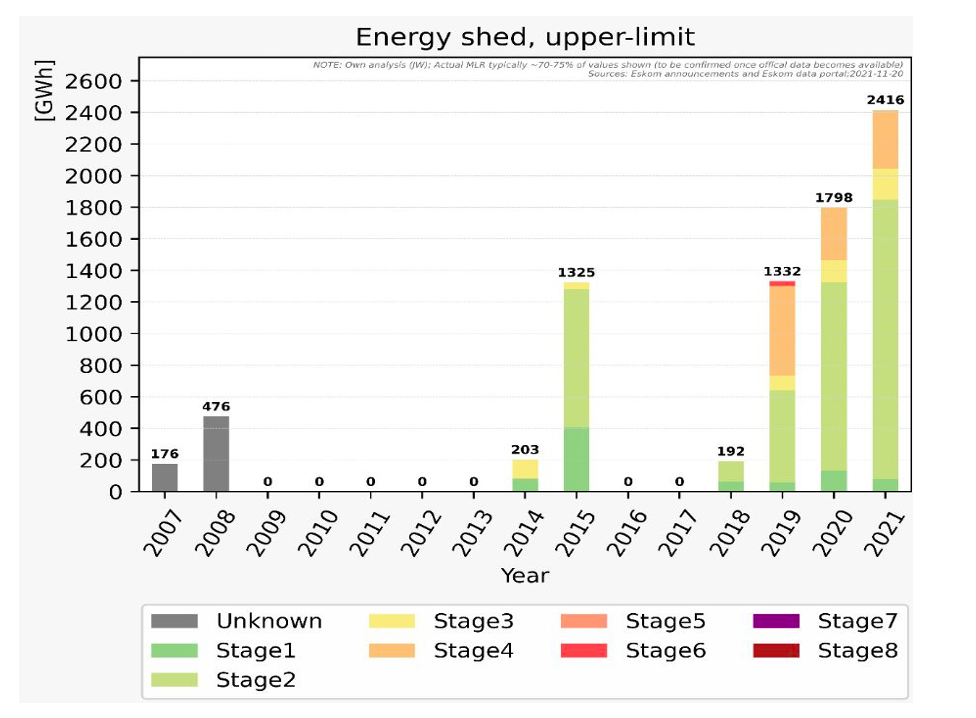POWER PREDICAMENT OP-ED
SA needs a ‘Marshall Plan’ to solve its load shedding crisis, or face a national disaster

Load shedding has become a national crisis, requiring a properly coordinated ‘Marshall Plan’. Failure could turn this national emergency into a national disaster — in the worst-case scenario, a national blackout with all its consequences.
South Africa has been experiencing load shedding intermittently for 25 years since 2007.
In recent years, the hours and energy lost to load shedding (Fig. 2 and Fig. 3) have been steadily increasing, while the energy availability factor of Eskom’s generation fleet (Fig. 1) has been steadily worsening. The trend continues in 2022.

Fig. 1: Eskom EAF for 2016, 2017, 2018, 2019, 2020, 2021 and 2022 to date. (Source: Data: Eskom; Graph: EE Business Intelligence)

Fig. 2: Hours of load shedding from 2014 to 2021. (Source: CSIR Energy Centre)

Fig. 3: Energy shed from 2014 to 2021. (Source: CSIR Energy Centre)
The impact of load shedding on the economy of South Africa has been devastating, contributing to low GDP growth and increasing levels of unemployment and poverty.
The public and customers of electricity are tired of hearing about why we are having load shedding, and instead want to hear about how we as a country are going to end load shedding, and fast.
It is quite clear that Eskom is unable to deal with this matter on its own through increased maintenance or delaying the decommissioning of old, poorly performing coal-fired power stations.
However, feelings of helplessness in the face of load shedding are completely unwarranted. There are indeed solutions available to end load shedding relatively soon, and at a relatively low cost to Eskom and the fiscus.
It is clear that load shedding in South Africa has become a national crisis, requiring a properly coordinated “Marshall Plan”, pulling in all affected stakeholders to become part of the solution.
Failure to attend to the load shedding crisis could turn this national emergency into a national disaster — in the worst-case scenario, a national blackout with all its consequences.
In the 1990s, the Eskom CEO at the time, Dr Ian McRae, conceived and initiated a similar national priority plan under the slogan: “Electricity for All”.
The project received the overwhelming support of the Eskom chairperson, board and workforce, as well as the committed support of the new, democratically elected government of South Africa.
Zweli Mkhize’s race against time and the Special Investigating Unit
In this project, under McRae’s stewardship, the word “problem” by Eskom people was not permitted or tolerated by the project team. Only potential solutions were allowed to be heard.
With the full support of government, municipalities and electricity customers, the “Electricity for All” initiative captured the imagination of the South African nation.
The campaign went on to become the biggest electrification project in the world at the time, earning international acclaim for its vision and success.
Today, South Africa and Eskom are faced with different challenges, which, with the necessary commitment and determination, are equally solvable.
The starting point should be a simple, clear national intent: namely to end load shedding fast. But the plan has to be more than only words — it must contain specific actions to be delivered upon.
So, to end load shedding fast, over and above any of the current public procurements, electricity customers, metro municipalities and Eskom must secure an additional 10,000MW of new wind and solar PV power generation capacity, and 5,000MW of battery storage capacity, within two years of being given the green light.
Detailed modelling shows conclusively that if executed properly and on time, this will stop load shedding in its tracks, and provide a measure of generation capacity reserve that will serve South Africa in good stead.
With the necessary will and commitment by government, Eskom, municipal metros and customers of electricity — big, medium and small — the rest is detail that can, must and will be achieved. I am not saying it will be easy, but it is most definitely achievable.
I believe this should be the undivided mission of government, Eskom, municipal metros, domestic, commercial, industrial, mining and agricultural customers of electricity, the Energy Council of South Africa, the Minerals Council of South Africa, the Energy Intensive User Group, and heavyweight electricity customers such as Sasol, South32, Arcelor Mittal, Anglo American and others, namely: to make this happen.
No naysayers or problem raisers should be tolerated — only problem solvers and solution providers.
Real engineers, with the support of the public and private sectors, should stand up for duty. I believe that engineers like nothing better than to be given a challenge and task that the naysayers and “Dolittles” say is impossible — just to prove them wrong.
Together, we must end load shedding fast. It can be done! DM
Chris Yelland is managing director, EE Business Intelligence.
[hearken id=”daily-maverick/9472″]

















 Become an Insider
Become an Insider
We need a different system of shredding if we are to try and save the economy. One part is the cost of the diesel peakers. Another is the chaos trying to run a factory with multiple random two hour outages.
Loadshredding should until eskom available capacity increases, be permanent:
All weekdays during peak period 6am to 9am and 6pm to 8pm.
All weekend.
With known breaks factories can schedule two solid shifts. Those with three shifts will shed that shift – that is what people get for voting for the ANC.
Yeah! Just do it!!
As one part of the solution, i urge you and your readers to read the following article. An approach that creates local jobs and spurs local manufacturing while steadily addressing the issue and without the risk of delay and/or corruption associated with big govt projects
https://www.biznews.com/news/2022/05/09/sa-education-renewable-energy
Oh come on Chris. You know as well as anyone living in SA that the problem does not lie with ‘the will’ of Eskom management. The problem is the anc. They will NEVER allow the CEO of Eskom to manage the utility on a ‘business’ basis. The first requirement is to get rid of approximately 40-50% of the people employed by Eskom. The second is to appoint qualified and experienced people (mostly whites?) who actually have the will to do a good job. The third is to get the deployed managers of Eskom, who have been named by Zondo to jail. The anc, via gwede mantashe, is blocking the introduction of ‘green power’ into the grid with their red tape (and being just plain hard-assed and stupid).
You took the words out of my mouth Gerrie !
Home solar with battery storage is part of the solution. Home owners should be encouraged to generate more than they need, and to feed their excess power into the grid. With the right incentives, thousands of small generators could rapidly become part of the solution.
There have been private sector businesses, both locally and internationally, who have started to step in 15 years or more ago (2007) to produce power which would filled the gap and go SA to “full power” 24×365. The problem has been politics and a greater interest in extracting personal rents, from both Eskom and other SOEs than running the businesses and country.